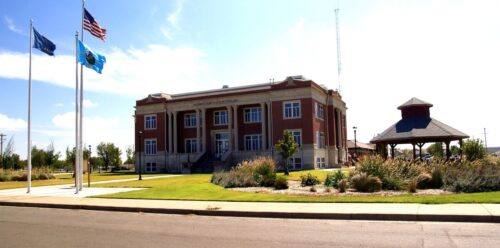SONY DSC

A High-Renewables Tomorrow, Today: Greensburg, Kansas
A small town in Kansas has taken a disaster and used the opportunity to emerge stronger and greener. While RMI’s Reinventing Fire campaign lays out a blueprint for ending our addiction to fossil fuels, Greensburg, Kansas is an on-the-ground example of how renewables can not only power our communities, but also help them thrive economically at the same time.
A Red Town Turned Green
In 2007, Greensburg, Kansas was a 1,400-resident rural farming town with declining population. The economy was struggling and its biggest claim to fame was that it was home to the world’s largest hand dug water well. In May of that year, tragedy struck when a class EF5 tornado—the strongest category in the tornado rating system—demolished the town. Over 95 percent of the buildings were flattened, along with the entire city’s electric distribution system. Instead of taking the insurance and FEMA money and moving away, the mostly religious mostly republican residents decided they not only wanted to rebuild, but wanted to rebuild in a way that made them stronger.
In the months following the tornado, with the help of Greensburg GreenTown, a community-based organization formed to help the town rebuild, the community held a 12-week process involving meetings and discussion with citizens, civic groups, business owners, and government officials. These meetings produced a Long-Term Recovery Plan and a Sustainable Comprehensive Plan for the next 20 years. One of the goals in these plans was to look towards renewable energy resources.
Green Building for Greensburg
To power Greensburg with as much renewables as possible, they realized that efficiency had to come first. So in December of 2007, only seven months after the tornado, the City Council adopted a resolution that all municipally owned buildings greater than 4,000 square feet be certified LEED Platinum and be designed to achieve all ten points possible under LEED EA Credit 1, the single most important credit in LEED. To earn those points, a project has to show a 42 percent reduction in predicted energy use compared with a base-case building. Currently, Greensburg has the highest concentration of LEED Gold and Platinum buildings in the U.S., which include the City Hall built using reclaimed brick from the town itself, the 48,000 square foot hospital which uses rainwater catchment and greywater, the passive solar arts center which sports a green roof, the K-12 school with its own wind turbine, the daylit and PV powered business incubator, and the renovated Kiowa County Courthouse, one of the few historic buildings in Greensburg to survive. These efforts to rebuild green are paying off, as thirteen buildings analyzed (eight of which are LEED certified) are saving a combined total of over $200,000 in energy costs per year.
Green Power
In 2009, through a 20-year power purchase agreement with Exelon Corporation, Greensburg installed a 12.5 megawatt wind farm that supplies enough electricity to power every house, business, and municipal building in the town, and then some. Over two-thirds of the power generated from the wind farm is currently excess power, and is actually placed back on the grid and offered as renewable energy credits for other Kansas Power Pool (of which Greensburg’s municipal utility is a member) customers. The hospital, school, arts center, and Best Western hotel all have dedicated wind turbines as well.
When the wind isn’t blowing Kansas Power Pool energizes the town with as much clean power as possible from other sources, including hydropower, to work toward the community’s goal of being powered entirely by renewable sources. The city also has ground source heat pumps, small PV systems, and is the first U.S. city to use LED lamps for 100 percent of its street lighting.
There are a few reasons this switch to renewable energy was so successful in a conservative town where most people would cringe to be called environmentalists. Residents say the tornado forced the town to make a cultural shift. Greensburg GreenTown founder Daniel Wallach said that city leaders were very careful to reframe the idea of rebuilding green away from its liberal connotation to the more traditional idea of conservation and sustainability, while also reminding people that their ancestors lived off the land, using the wind and the sun. Wallach spent the first few months just talking to residents and getting them behind the idea of rebuilding green.
Greensburg today is known for more than just a big well, which is what the residents had hoped for. According to Wallach, “public awareness of Greensburg is a million times greater than it would have been if we didn’t rebuild in this way.” The local John Deere dealership became a wind turbine distributor, generating many new jobs, and the number of visitors to the town has definitely increased. “Greensburg is a living laboratory,” said Wallach, “and people are captivated by the story.” Visitors from all over the world visit Greensburg, and each visitor is encouraged to walk the GreenTour and given a map and booklet of all of Greensburg’s innovations. Greensburg GreenTown is also developing a handbook for sustainable disaster recovery, to help other towns hit by disasters to follow their lead. Greensburg, Kansas has shown that it is possible to become a 100 percent renewably powered community without government mandates or controversial and partisan laws but with only the will of the people and their commitment to building a stronger community.
As Greensburg, Kansas has shown, it is possible to power our towns and cities with renewables. And not only possible, but economically beneficial. As climate expert and MIT professor Jon Sterman said referring to Greensburg, “it isn’t a choice between a healthy economy or a healthy environment. It’s about preserving the environment so we can have a healthy economy.”
Images courtesy of Joah Bussert via Greensburg GreenTown